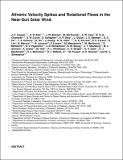Alfvénic velocity spikes and rotational flows in the near-Sun solar wind
Author(s)
Kasper, J. C.; Bale, S. D.; Belcher, John Winston; Berthomier, M.; Case, A. W.; Chandran, B. D. G.; Curtis, D. W.; Gallagher, D.; Gary, S. P.; Golub, L.; Halekas, J. S.; Ho, G. C.; Horbury, T. S.; Hu, Q.; Huang, J.; Klein, K. G.; Korreck, K. E.; Larson, D. E.; Livi, R.; Maruca, B.; Lavraud, B.; Louarn, P.; Maksimovic, M.; Martinovic, M.; McGinnis, D.; Pogorelov, N. V.; Richardson, J. D.; Skoug, R. M.; Steinberg, J. T.; Stevens, M. L.; Szabo, A.; Velli, M.; Whittlesey, P. L.; Wright, K. H.; Zank, G. P.; MacDowall, R. J.; McComas, D. J.; McNutt, R. L.; Pulupa, M.; Raouafi, N. E.; Schwadron, N. A.; ... Show more Show less
DownloadAccepted version (7.597Mb)
Publisher Policy
Publisher Policy
Article is made available in accordance with the publisher's policy and may be subject to US copyright law. Please refer to the publisher's site for terms of use.
Terms of use
Metadata
Show full item recordAbstract
The prediction of a supersonic solar wind1 was first confirmed by spacecraft near Earth2,3 and later by spacecraft at heliocentric distances as small as 62 solar radii4. These missions showed that plasma accelerates as it emerges from the corona, aided by unidentified processes that transport energy outwards from the Sun before depositing it in the wind. Alfvénic fluctuations are a promising candidate for such a process because they are seen in the corona and solar wind and contain considerable energy5–7. Magnetic tension forces the corona to co-rotate with the Sun, but any residual rotation far from the Sun reported until now has been much smaller than the amplitude of waves and deflections from interacting wind streams8. Here we report observations of solar-wind plasma at heliocentric distances of about 35 solar radii9–11, well within the distance at which stream interactions become important. We find that Alfvén waves organize into structured velocity spikes with duration of up to minutes, which are associated with propagating S-like bends in the magnetic-field lines. We detect an increasing rotational component to the flow velocity of the solar wind around the Sun, peaking at 35 to 50 kilometres per second—considerably above the amplitude of the waves. These flows exceed classical velocity predictions of a few kilometres per second, challenging models of circulation in the corona and calling into question our understanding of how stars lose angular momentum and spin down as they age12–14.
Date issued
2019-12Department
MIT Kavli Institute for Astrophysics and Space ResearchJournal
Nature
Publisher
Springer Science and Business Media LLC
Citation
Kasper, J.C. et al. "Alfvénic velocity spikes and rotational flows in the near-Sun solar wind." Nature 576, 7786 (December 2019): 228–231 © 2019 The Author(s)
Version: Author's final manuscript
ISSN
0028-0836
1476-4687